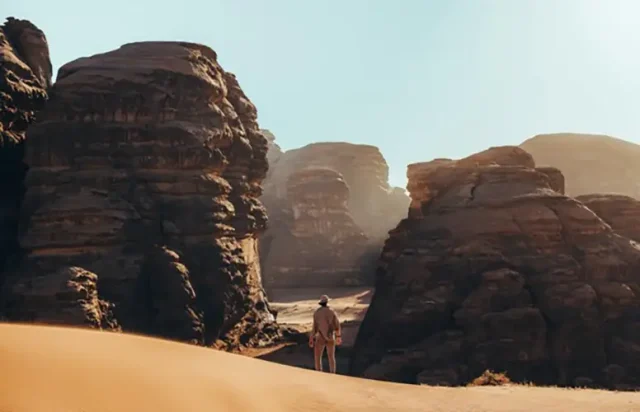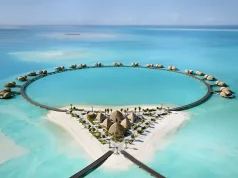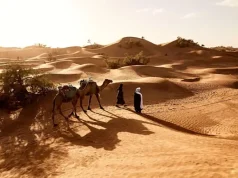
Saudi Arabia is known for its popular tourist spots. It has beautiful landscapes, a religious legacy, a lively culture, and a rich history. Saudi Arabia showcases the world’s most remarkable natural sceneries and incredible architectural wonders. Its official name is the Kingdom of Saudi Arabia by ibn Saud King Abdulaziz. Formally declared in 1932, Saudi Arabia nestles in the heart of the Arabian Peninsula, situated on the western highlands along the Red Sea and the southern coast along the Persian Gulf.
As we begin our journey on this cultural crossroads, we are pleasantly reminded of the historical civilisations that once inhabited this part of the world, braving its dreadful desert climate. Saudi Arabia is not an artefact; it’s a living, breathing country with the rhythm of progress and transformation. Saudi Arabia offers warm hospitality and invites travellers to explore it. Here, we discuss the top seven interesting facts about Saudi Arabia.
World’s Largest Airport is in Dammam
King Fahad International Airport is in Dammam, Saudi Arabia. It is the world’s first largest international airport by land area. King Fahd International Airport in Saudi Arabia, a modern airport architect, possesses one of the longest surfaced runway distances, stretching to as much as 4,000 meters in length. This successful vision empowers the airport to handle various planes, like the largest aircraft Airbus A380, making it an important global transit hub. Furthermore, it plays an important role as an international transit hub of the Arabian Peninsula, offering a Middle Eastern gateway to global travellers by connecting to numerous international destinations and providing access to fascinating Saudi Arabian cities full of historical and cultural attractions. Here are some points that make King Fahad International Airport the world’s largest International Airport.
- The total area of King Fahad International Airport is 1,92,000 acres
- It is the world’s third-largest airport, with passenger volumes receiving about 10 million annually
- This man-made wide-range architectural structure began operating in 1999.
In addition, King Fahd International Airport has an enriched modern and luxurious terminal complete with an elegant architectural design and modern additional facilities. Multiple facilities may be available to passengers transiting through this bustling aviation terminal hub, including upscale shopping facilities, quality dining services, comfortable resting areas, and other superior services that cater to all passengers. Moreover, Other desirable travel services are available right from when the passenger arrives at the airport or terminal until when passengers take off.
World’s Largest Sandy Desert
Rub al Khali, also referred to as the Empty Quarter, is the world’s largest continuous sandy desert nestled in Saudi Arabia. This vast area of stretches of dunes covers approximately 650,000 square kilometres of the area on the southern portion of the Arabian Peninsula. Rub’al Khali is a breathtaking area to explore as it is covered with dunes up to 250 meters and decorated by winds in a very artistic way. It is only partially explored and has a mystery; it attracts explorers and historians alike through its mystery.
Furthermore, the UNESCO World Heritage Site of Al-Diriyah is also in Saudi Arabia. It is one of the oldest cities in the world, and people live in it. Al-Diriyah, situated on the outskirts of Riyadh, was the capital of the Al Saud dynasty and played a crucial part in creating the contemporary Kingdom of Saudi Arabia. Its historical significance is clear; its mud-brick building structure and narrow lanes look into the Kingdom’s memorable past. Today, Al-Diriyah represents Saudi Arabia’s rich cultural history, attracting travellers to explore its intricate pathways and historic sites.
World’s First largest mosque in Saudi Arabia
Saudi Arabia is a land of religious heritage. Millions of devotees travel to Saudi Arabia each year to visit the sacred mosque. Al-Masjid al-Haram is the World’s First Largest Mosque and is considered the first holy place for Muslims. According to (Wikipedia) 3.0 Million Muslims can easily pray in this beautiful mosque. Every Muslim wishes to visit this sacred place once in a lifetime. Pilgrims can see this beautiful architectural structure through Umrah Packages. People visit this mosque to seek blessings from Allah (SWT) and develop a strong faith and connection with him.
Second Largest Mosque in the World
Moreover, the second holiest place for Muslims is the Prophet Mosque in Madinah. It is also considered the world’s second-largest mosque. It is also the burial place of Prophet Mohammad (PBUH). This beautiful, breathtaking ancient architectural structure was initially constructed by the Prophet (PBUH). Millions of Muslims visit this magnificent mosque annually. The mosque’s architecture represents Islamic art and history. 1.5 million Muslims can offer prayers inside the Prophet Mosque. People visit this mosque to get helpful information about the ancient history of Islam.
2nd world’s largest oil reserves in the world
Saudi Arabia has the world’s second-largest proven oil reserves, making it a significant player in the global energy market. The Kingdom’s economic growth and geopolitical influence made it a critical participant in the global oil market. In addition, Saudi Arabia has utilised its vast oil wealth to support ambitious development projects and diversify its economy while exerting substantial influence on international energy policies and diplomacy.
Additionally, Saudi Arabia’s oil reserves are substantial and essential for the global economy since the country plays a vital role in keeping the oil market stable and safe. Saudi Arabia is a prominent member of the Organisation of Petroleum Exporting Countries (OPEC). It can influence oil rates and production levels, which affect countries all over the world. The kingdom’s significance on the global stage is underscored by the fact that its oil wealth has transformed its fortunes and the economic fortunes of countries worldwide, demonstrating its international fame.
Cutting-Edge Water Management Techniques
Saudi Arabia has no river system. Despite its extensive geography, its arid climate and desert landscape are the primary reasons for its lack of natural river systems. The government uses cutting-edge water management methods like purification plants and large-scale groundwater mining to solve water management issues. This fact emphasises the significance of environmentally responsible resource management in an area where water is valuable.
In contrast to the lack of natural rivers, Saudi Arabia is the world’s largest exporter of petroleum due to its huge oil reserves. This fact emphasises the country’s strategic importance in influencing foreign policy and economic dynamics and its substantial influence in global energy markets.
Camel trading is still a big business
In Saudi Arabia, camel trading is a vibrant industrial sector profoundly ingrained in the country’s economic and cultural fabric. The largest camel market in Riyadh sells around 100 camels daily. It is also the world’s biggest market. Additionally, this market covers two square miles on the outskirts of Burayadh in Al-Qassim and is open every day in the early morning. The value of camels remains significant due to their use in traditional activities, including transportation, racing, and cultural events. Moreover, camels continue to play an important role, where traders negotiate deals and exhibit prised camels in the vibrant camel markets in the country, reflecting the enduring significance of these animals in Saudi society.
In addition, Saudi Arabia is famous for selling camels and has some of the world’s largest deserts, such as the Rub’ al Khali or Empty Quarter. Saudi Arabia also hosts the King’s Cup camel race. During the Janadriyah National Festival, a 19-kilometre camel race can attract as many as 2000 participants.
World’s first 3D-printed Mosque in Jeddah
The world’s first 3D-printed mosque opened in Jeddah on March 6, 2024. This is a big step forward, seamlessly integrating technology and tradition. People called the mosque the Abdulaziz Abdullah Sharbatly Mosque, also known as the Friday Mosque. This beautiful mosque covers over 5,600 square metres. The mosque, which reflects Hejazi architecture, is the first in the world to use 3D printing technology. This architectural marvel exemplifies the kingdom’s embrace of innovation and pays tribute to its rich cultural legacy.
Additionally, this mosque is a place of worship and a symbol of Saudi Arabia’s forward-looking vision. The latest cutting-edge technology has carefully crafted these intricate designs. The best month is December approaches; the peak season for Umrah pilgrims coincides with the pleasant climate in Saudi Arabia. People can efficiently perform their spiritual rituals and take blessings from Allah (SWT). The December Umrah Packages allow people to see this stunning architectural structure during their Umrah trip and learn exciting facts about Saudi Arabia.
Final Thoughts
After reading these interesting facts about Saudi Arabia, it becomes more apparent why this country is so demanding. From the world’s largest Airport (King Fahad International Airport), a modern aviation marvel, to the breathtaking Rub’ al Khali desert, every part of Saudi Arabia reflects its rich tapestry of history and innovation. For those seeking spiritual growth, Umrah Packages provides a pathway to the world’s largest mosques, Al-Masjid al-Haram and Masjid an-Nabawi, where millions of people find peace. From the vast oil reserves to the enduring tradition of camel trading that shapes global economics. And with the world’s first 3D-printed mosque, Jeddah serves as a beacon of innovation, seamlessly integrating tradition and technology. Saudi Arabia invites visitors to reveal its depths and discover its mysteries as it unveils more of its treasures with every visit.





